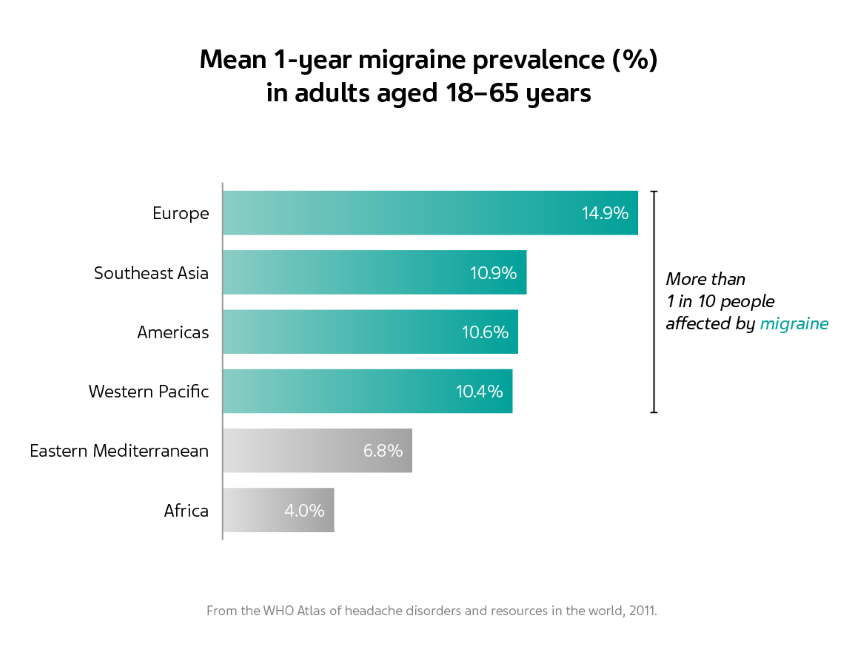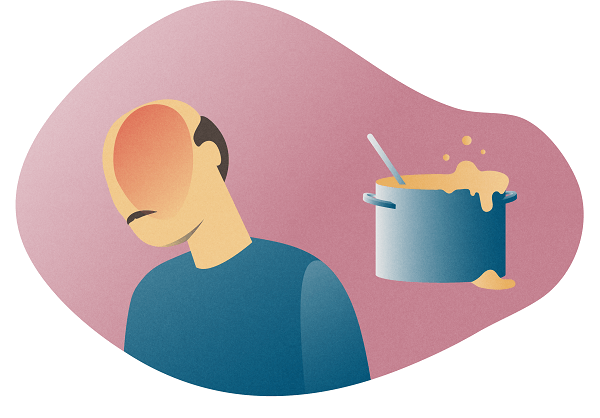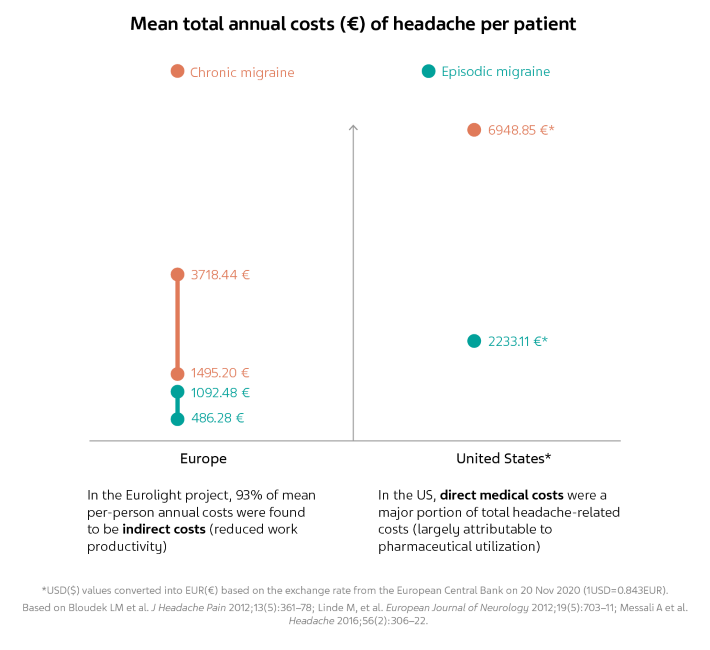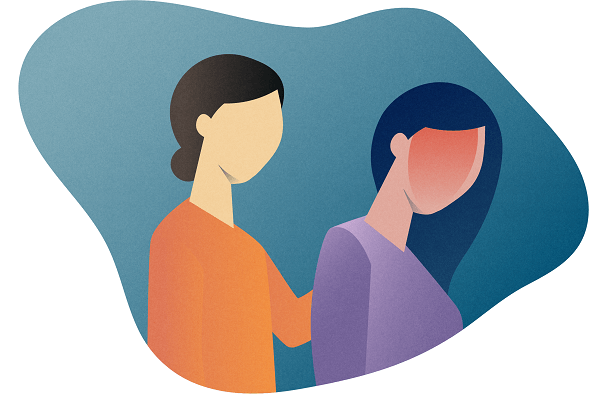
Burden of migraine: A ripple effect from individuals to society
Over 1 billion people in the world live with migraine, which ranks second for years lived with disability (YLD) according to the 2016 Global Burden of Disease (GBD) study.1 Migraine not only burdens the lives of individuals who experience it, but also their friends, family, and colleagues—the multifaceted impact of migraine on society as a whole is far from trivial and needs attention.2
Migraine is prevalent and a leading cause of disability
PREVALENCE OF MIGRAINE
According to the 2016 GBD study, the global age-standardized prevalence of migraine was 14.4% overall.1 When further stratified by sex, the prevalence was 18.9% for women, and 9.8% for men.1 The varied prevalence across global regions detailed in the GBD study1 was also reflected in the results of a World Health Organization (WHO) study reporting that migraine affected more than 10% of adults aged 18–65 years, except in Africa and the Eastern Mediterranean region (Figure 1).3
The WHO also reported that 1.7%–4.0% of the global adult population aged 18–65 years experienced ≥15 monthly headache days (MHDs), although this category included people living with medication overuse headache (MOH) in addition to chronic migraine (CM).3 Similar figures for prevalence of CM (with or without MOH) have been reported in several other studies.2

Figure 1. Mean 1-year migraine prevalence (%) in adults aged 18–65 years from population-based stuImadies by WHO region (WHO Atlas of headache disorders and resources in the world, 2011).
DISABILITY AND QUALITY OF LIFE
The 2016 GBD study showed that headache—particularly migraine—is a leading cause of disability in 195 countries, especially affecting young and middle-aged women.1 Migraine was estimated to have caused 45.1 million cumulative years of life lived with disability (YLDs)—an increase of 51.2% from findings in 1990.1 Over five percent of total YLDs measured were attributed to migraine (6.8% for women and 4.3% for men), and prevalence and YLD rates peaked in the age group of 35–39 years.1 Across both sexes, YLDs were highest in individuals aged 15–49 years (8.2%), but was also high in children aged 5–14 years (4.5%), individuals aged 50–69 years (4.2%), and the elderly over 70 years of age (1.3%).1
Disability associated with migraine is most commonly measured using the Migraine Disability Assessment (MIDAS) or the Headache Impact Test (HIT-6), among others.2 Generally, people living with migraine experience worse disability or quality of life (QoL) compared with those who are living with tension-type headache or are headache-free.2 Additional characteristics such as higher headache frequency, menstrual-related migraine, and comorbidities are associated with higher disease burden, disability, and lower QoL.2 Notably, data on global headache burden are still scarce despite widespread prevalence, as most epidemiological studies have been conducted in high-income countries.1
Burden of migraine impacts the individual, their interpersonal relationships, and larger society
In everyday life, the burden of migraine manifests as a multilevel and complex interplay of challenges.2 Among the main themes surrounding the burden of migraine,2 we elaborate below on the impact of migraine on work, school activities, and family, as well as interictal burden and disease costs.

IMPACT ON SCHOOL ACTIVITIES AND WORK
A study in 1994 examining school-aged children aged 5–15 years found that 10.6% lived with migraine, and these children missed 4.1 more school days per year on average compared with children who were headache-free.4 Later in 2014, a study with participants aged 6–17 revealed that 23.1% of children living with migraine lost ≥1 school day, 21.8% left school early on ≥1 day, and 59.9% lost ≥1 day of other activities during the preceding month.5 Notably, this study also highlighted that 7.1% of parents whose children had headache left work on ≥1 day during the preceding month—this number rose to 18.2% when their children had ≥15 MHDs.5
For working adults, the impact of migraine on work productivity has been scrutinized across multiple studies, with results suggesting that people living with migraine lose an average of 10.2 (range: 3.2–89.2) work-equivalent days per year.2 Due to presenteeism, people living with migraine also spend more days working with reduced productivity.2 Validation studies using HEADWORK—a questionnaire addressing difficulties in work-related activities and contributing factors—have corroborated previous results, showing higher work-related difficulties are associated with higher disability, lower quality of life, lower productivity, higher headache frequency, and higher pain intensity.6 In a study quantifying stigma attributed to migraine, CM scored higher on the stigma scale compared with EM, and stigma scores correlated strongly with the inability to work.7

IMPACT ON FAMILY LIFE
The Eurolight project included data on the personal impact of migraine in family life.8 Of people living with migraine, 5.5% reported that migraine had affected their family planning, and 17.8% had difficulties in their love life in the last 3 months due to headache.8 Moreover, 18.2% claimed their headache prevented them for caring for their children, and 9.1% confirmed their headache caused their partner to miss social activities during the last 3 months.8 In most cases, responders belonging to these subsets were more likely to report a higher headache frequency compared with those who responded negatively.8
In the Chronic Migraine Epidemiology and Outcomes (CaMEO) study, one or more incidences of reduced participation in family activities due to migraine was reported in 48.2%–57.4% of people living with migraine.9 Depending on headache frequency, 24.4%–43.9% of people living with migraine perceived that their partner did not believe the severity or impact of their headache, and about one-third expressed worry about long-term financial security due to their headache.9
Consistently, a moderate-to-strong impact on the ability to participate in home life and social or leisure activities has been reported for headache-free people who live with or are a family member of a person living with migraine.10 The Impact of Migraine on Partners and Adolescent Children (IMPAC) scale may help to more robustly measure family burden and provide quantifiable data on the impact of migraine on family dynamics.11

INTERICTAL BURDEN
Even during interictal periods, people living with migraine were found to be significantly less physically active, and exhibited lower motility when active, compared with healthy controls.12 In addition, people living with migraine subjectively reported a lower level of activity, lower vigor, and heightened sleepiness during a substantial part of an interictal day.12 Comorbidities are also a major source of interictal burden for people living with both CM and episodic migraine (EM), as results from the American Migraine Prevalence and Prevention (AMPP) study have reported high rates of depression (30.19% for CM; 17.24% for EM) and anxiety (30.23% for CM; 18.79% for EM) among others.13
The Eurolight project reported that 26.0% of people living with migraine experienced interictal symptoms, with 10.6% reporting interictal anxiety and 14.8% reporting avoidance (lifestyle compromise).14 Interictal anxiety and avoidance significantly increased with headache intensity and frequency.14 Notably, about one-third of people living with migraine were reluctant to talk to others of their headache, about 10% felt their families and friends did not understand their headache, and nearly 12% reported their employers and colleagues did not understand their headache.14
DISEASE COSTS
Reported costs of migraine vary depending on the cost structure of the geographical location of the study, as well as the year(s) in which costs were measured.2 Generally, studies agree that the costs of CM are significantly higher than the costs of EM.2 In the 2012 International Burden of Migraine Study (IBMS), mean total annual costs per patient across 5 European countries ranged €1495.20–€3718.44 for CM, and €486.28–€1092.48 for EM (Figure 2).15 Consistently, the Eurolight project reported €1222 as the mean per-person annual cost for migraine across 8 European countries in 2012, 93% of which was indirect costs (work absenteeism and reduced productivity at work).16 Notably, the Eurolight project also showed that the total annual cost of migraine in adults aged 18–65 years in the European Union was €111 billion.16
In a 2016 study in the United States, mean total annual cost of headache among people living with CM ($8243) was over three times that of people living with EM ($2649), with those living with CM having significantly greater direct medical and indirect (lost productivity) costs compared with people living with EM (Figure 2).17 Notably in the US, direct medical costs were a major portion of total headache-related costs for both people living with CM and with EM, of which a large portion was attributable to pharmaceutical utilization.17 On societal costs, the AMPP study reported that lost productive time (LPT) was significantly higher, more costly, and increases more rapidly for people living with CM compared with EM as a person living with migraine gets older in age.18

Figure 2. Mean total annual costs (EUR) of headache per patient in Europe and the US.
Shifting the framework to alleviate the burden of migraine
The experience of disease burden widely varies for people living with migraine, depending on many factors including frequency of migraine days and severity of symptoms.2 In addition to personal burden creating hardships in day-to-day life, work-related costs due to reduced productivity contribute to a bigger economic impact of migraine.2 By furthering education and research around migraine and increasing the collective understanding of the disease, society can start to help alleviate the burden of migraine.2

Stovner LJ, Nichols E, Steiner TJ, et al. Global, regional, and national burden of migraine and tension-type headache, 1990–2016: a systematic analysis for the Global Burden of Disease Study 2016. The Lancet Neurology 2018;17(11):954–76.
Leonardi M, Raggi A. A narrative review on the burden of migraine: when the burden is the impact on people’s life. The Journal of Headache and Pain 2019;20(1):41.
WHO | Atlas of headache disorders and resources in the world 2011 [Internet]. WHO. [cited 2020 Nov 17];Available from: https://www.who.int/mental_health/management/atlas_headache_disorders/en/
Abu-Arefeh I, Russell G. Prevalence of headache and migraine in schoolchildren. BMJ 1994;309(6957):765–9.
Wöber-Bingöl Ç, Wöber C, Uluduz D, et al. The global burden of headache in children and adolescents - developing a questionnaire and methodology for a global study. J Headache Pain 2014;15:86.
Raggi A, Covelli V, Guastafierro E, et al. Validation of a self-reported instrument to assess work-related difficulties in patients with migraine: the HEADWORK questionnaire. The Journal of Headache and Pain 2018;19(1):85.
Young WB, Park JE, Tian IX, Kempner J. The stigma of migraine. PLoS One 2013;8(1):e54074.
Steiner TJ, Stovner LJ, Katsarava Z, et al. The impact of headache in Europe: principal results of the Eurolight project. 2014;11.
Buse DC, Scher AI, Dodick DW, et al. Impact of Migraine on the Family: Perspectives of People With Migraine and Their Spouse/Domestic Partner in the CaMEO Study. Mayo Clinic Proceedings 2016;91(5):596–611.
MacGregor EA, Brandes J, Eikermann A, Giammarco R. Impact of migraine on patients and their families: the Migraine And Zolmitriptan Evaluation (MAZE) survey--Phase III. Curr Med Res Opin 2004;20(7):1143–50.
Lipton RB, Buse DC, Adams AM, Varon SF, Fanning KM, Reed ML. Family Impact of Migraine: Development of the Impact of Migraine on Partners and Adolescent Children (IMPAC) Scale. Headache 2017;57(4):570–85.
Stronks DL, Tulen JHM, Bussmann JBJ, Mulder LJMM, Passchier J. Interictal daily functioning in migraine. Cephalalgia 2004;24(4):271–9.
Buse DC, Manack A, Serrano D, Turkel C, Lipton RB. Sociodemographic and comorbidity profiles of chronic migraine and episodic migraine sufferers. J Neurol Neurosurg Psychiatry 2010;81(4):428–32.
Lampl C, Thomas H, Stovner LJ, et al. Interictal burden attributable to episodic headache: findings from the Eurolight project. J Headache Pain 2016;17:9.
Bloudek LM, Stokes M, Buse DC, et al. Cost of healthcare for patients with migraine in five European countries: results from the International Burden of Migraine Study (IBMS). J Headache Pain 2012;13(5):361–78.
Linde M, Gustavsson A, Stovner LJ, et al. The cost of headache disorders in Europe: the Eurolight project: Cost of headache in Europe. European Journal of Neurology 2012;19(5):703–11.
Messali A, Sanderson JC, Blumenfeld AM, et al. Direct and Indirect Costs of Chronic and Episodic Migraine in the United States: A Web-Based Survey. Headache 2016;56(2):306–22.
Serrano D, Manack AN, Reed ML, Buse DC, Varon SF, Lipton RB. Cost and Predictors of Lost Productive Time in Chronic Migraine and Episodic Migraine: Results from the American Migraine Prevalence and Prevention (AMPP) Study. Value in Health 2013;16(1):31–8.



